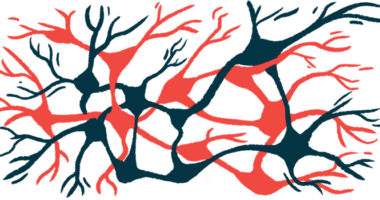Juvenile-onset ALS linked to new SPTLC2 mutation: Study
Increased sphingolipid production led to muscle weakness, motor impairment

A previously unknown mutation in the SPTLC2 gene was identified in two patients who developed juvenile-onset amyotrophic lateral sclerosis (ALS), a study reports.
The mutation significantly increased the production of certain types of fat-like molecules called sphingolipids, resulting in early-onset muscle weakness, progressive motor impairment, and involuntary tongue movements.
“This is the first time we’ve shown that mutations in the gene SPTLC2 are a cause for ALS,” senior author Stephan Züchner, MD, PhD, co-director of the John P. Hussman Institute for Human Genomics at the University of Miami, Florida, said in a university news release. “Now, having identified this genetic anomaly, labs can begin looking for potential therapies.”
Details of the discovery were published in the Journal of Neurology, Neurosurgery and Psychiatry in “Recurrent de-novo gain-of-function mutation in SPTLC2 confirms dysregulated sphingolipid production to cause juvenile amyotrophic lateral sclerosis.”
ALS is a progressive disease caused by the degeneration of motor neurons — specialized nerve cells in the brain and spinal cord that aid movement, speech, swallowing, and breathing — leading to paralysis and death.
Gene mutations and juvenile ALS
Mutations in the SPTLC1 gene were recently associated with the juvenile form of ALS, which develops in people younger than age 25. The gene carries instructions for a component of the serine-palmitoyltransferase (SPT) complex, an enzyme involved in producing sphingolipids, a type of fat essential for brain function. Defects in the gene associated with ALS result in an increase in enzyme activity, called gain of function.
SPTLC1 mutations also cause hereditary sensory and autonomic neuropathy type 1 (HSAN1). A slowly progressive neurological disorder, HSAN1 is marked by sensory loss in the limbs and impairment of the autonomic nervous system, which controls involuntary functions.
“SPT is a really interesting protein complex,” Züchner said. “If mutations occur in one region of the complex, this results in a motor neuron disease. However, similar mutations affect other parts of the same complex and this creates a sensory deficit disorder.”
The SPT complex is made of two core proteins, SPTLC1 and SPTLC2. Since both interact with downstream proteins to exert SPT-related functions, mutations in the SPTLC2 gene could be similarly associated with juvenile-onset ALS, researchers hypothesized.
To detect and examine people who may harbor SPTLC2 mutations, Züchner and his colleagues screened the genome of 700 genetically unsolved motor neuron disease cases.
Two cases of juvenile-onset ALS
The team detected an SPTLC2 mutation, called Met68Arg, in two unrelated patients. They both presented with early-onset muscle weakness, involuntary movements of the tongue (oral fasciculations), and pyramidal signs, or dysfunction of the upper motor neurons connecting the brain and spinal cord.
A man of Turkish-Bulgarian origin in his 20s had delays in motor milestones and started walking at 26 months. In early childhood, he had difficulty rising from the floor, walked on his toes, and had hand tremors from age 3. He was diagnosed with juvenile ALS when he was 14.
By 15, he developed swallowing difficulties and a hoarse voice, and by 18, he was unable to walk without assistance. He underwent a tracheostomy at age 22 (hole in the windpipe) to assist his breathing and, at recent examinations, was bedridden and could only use two fingers on both hands.
The second case was an African-American woman who, at age 5, had slurred speech. She reached normal motor milestones, but developed scoliosis (a sideways curvature of the spine), muscle weakness and wasting, and oral fasciculations by age 10. An electromyography at age 12 to assess nerve-muscle function showed abnormalities.
By 18, she couldn’t rise from the floor and showed progressive weakness in muscles related to speech, swallowing, and breathing, which required periodic breathing support. A muscle ultrasound showed signs of fat infiltration and scarring and spontaneous twitches in multiple muscles close to her body (proximal) and in the limbs (distal). She had no signs of sensory problems.
The SPTLC2 gene variant was absent in large control datasets of thousands of ALS families or cases. Analyses showed the mutation affected the interaction between the SPTLC2 protein and ORMDL3, a protein that regulates sphingolipid production.
“We hypothesised that impaired ORMDL3 interaction might consequently result in an altered homoeostatic [balance] control and increased [sphingolipid] formation,” the researchers wrote.
In fact, sphingolipid profiles in the bloodstream of the two patients differed from those of unaffected family members and unrelated healthy controls, and showed increases in various types of sphingolipids and related molecules.
“Understanding SPTLC2 genetics is important on a scientific level, as well as for patient care,” Züchner noted. “There is a drug in clinical trials that targets SPTLC2 to treat sensory neuropathy. However, if we gave the same drug to an ALS patient, it would probably be a disaster. The mutations are that different.”
Using a human cell line that carried the mutations, researchers confirmed significant increases in various types of sphingolipids, including dihydro-ceramides and dihydro-sphingomyelins, as well as ceramides and sphingomyelins.
Compared with mutations in the related SPTLC1 gene, which also causes an increase in sphingolipid production, levels of sphingolipids in cells with the SPTLC2 mutation were even higher.
“SPTLC2 represents a new [ALS gene], highlighting a key role of dysregulated sphingolipid synthesis in the [development] of juvenile ALS,” the researchers said. “Given the direct interaction of SPTLC1 and SPTLC2, this knowledge might open new therapeutic avenues for motor neuron diseases.”







